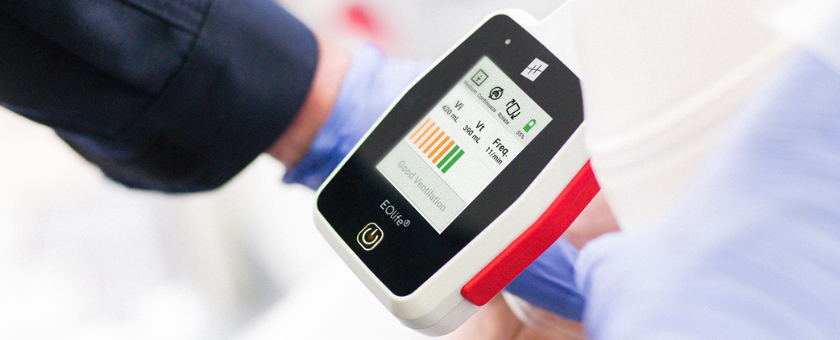In a recently published position paper in the EUSEM Journal, a coalition of world-renowned physicians and researchers has united behind a bold, evidence-based stance: Ventilation Feedback Devices (VFDs) – such as EOlife – should be universally adopted as part of standard cardiopulmonary resuscitation (CPR).
Their expert opinion is clear — to dramatically improve survival after cardiac arrest, it is no longer acceptable to ignore ventilation. VFDs represent a vital advancement in resuscitation science, offering the potential to elevate the quality of care and transform outcomes worldwide.
The missing link in the chain of survival
Over the past two decades, CPR has seen major breakthroughs: the deployment of automated external defibrillators (AEDs), emphasis on high-quality chest compressions, and refined algorithms. Yet, despite these improvements, survival rates from out-of-hospital cardiac arrest remain below 10% globally.
The authors point to a critical and often overlooked factor: ventilation has been left behind. While compression techniques have been optimized, ventilation practices remain inconsistent, imprecise, and largely unmeasured during resuscitation efforts. This, they argue, is a dangerous oversight that demands immediate correction.
They call for a paradigm shift — from a narrow focus on compressions to a comprehensive approach that includes evidence-driven cardiopulmonary resuscitation.
Striking evidence, stark reality
Recent studies cited in the paper show that measurable ventilation during CPR is associated with up to a fivefold increase in favorable neurological outcomes. This underscores the essential role of ventilation in resuscitation success.
However, the experts highlight a troubling gap between guidelines and practice. Across both simulated and real-life settings, studies consistently reveal poor adherence to ventilation recommendations — due to inadequate training, lack of real-time feedback, and over-reliance on manual techniques.
Attempts to mitigate this with smaller bag sizes or dual-rescuer strategies have proven insufficient. The authors argue that these solutions fail to address the core issue: clinicians are being asked to perform a critical intervention blindly.
Why VFDs are the answer ?
In this context, Ventilation Feedback Devices emerge as the missing piece of the resuscitation puzzle. These tools offer real-time data on tidal volume and ventilation rate, enabling clinicians to stay within guideline targets and deliver optimal care — even in high-stress, dynamic environments.
The paper positions VFDs as the modern equivalent of compression feedback devices: a technology that transforms invisible processes into measurable, actionable parameters. They allow providers to ventilate with precision, reduce the risk of hypoventilation or hyperventilation, and ensure every breath counts.

EOlife, the only Ventilation Feedback Device (VFD) to display the volume of gas reaching the patient’s lungs (Tidal Volume).
CE-marked and FDA-cleared medical device enabling real-time measurement of insufflated volume, tidal volume, and ventilation frequency. It provides visual feedback to deliver ventilation following ERC or AHA recommendations.
A call to action: make VFDs the global standard
The authors conclude with a strong call to action: ventilation must no longer be the blind spot of resuscitation. Integrating VFDs into CPR is not just an innovation — it is a necessary evolution. With the potential to triple survival and quintuple favorable neurological outcomes, VFDs offer a game-changing leap in care quality.
To accelerate this shift, they propose four urgent priorities:
- Embed VFDs in Advanced Life Support (ALS) training programs, ensuring every provider learns to ventilate with feedback from the start;
- Update international CPR guidelines with explicit recommendations for VFD use in both prehospital and in-hospital settings;
- Implement hospital-based quality improvement initiatives to monitor, measure, and continuously improve ventilation performance;
- Support ongoing clinical research and technological innovation, to further validate and refine the use of VFDs in diverse clinical contexts.
This expert consensus sends a clear and urgent message: to improve outcomes, we must ventilate better — and we can no longer afford to do it blindly. The time has come for VFDs to become the new standard in every resuscitation effort, worldwide.

Are you interested in EOlife ?
Learn more
Reference
Khoury, Abdoa,b; Hachimi-Idrissi, Saidc,d,e; The RACE Study Group. Ventilation feedback devices in cardiopulmonary resuscitation: bridging the gap for optimal resuscitation practices. European Journal of Emergency Medicine ():10.1097/MEJ.0000000000001252, July 07, 2025. | DOI: 10.1097/MEJ.0000000000001252


